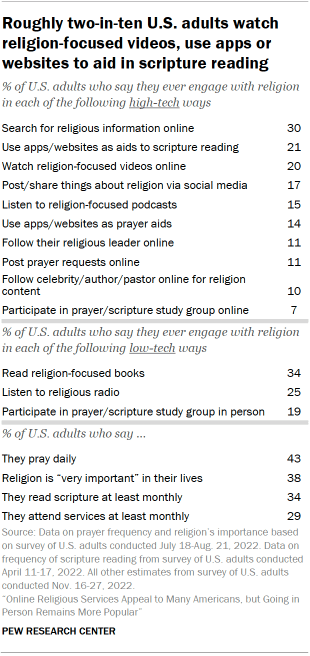
Technological innovations brought on by the internet have touched virtually all aspects of human life, including religion. In addition to letting people stream religious services, apps and websites can help people pray, read scripture, learn about religion, and participate in online prayer groups, among other things.
Still, the usage of some comparable “analog” technologies is more common. For example, 79% of highly religious U.S. adults read religion-focused books, higher than the 45% who watch religion-focused videos online. Nearly six-in-ten highly religious adults (57%) listen to religion-focused radio stations, higher than the 38% who listen to religion-focused podcasts. And 61% of highly religious adults go to prayer groups or scripture study groups in person, compared with 19% who join such groups online.
That said, digital technology clearly has a foothold among highly religious Americans (defined, for the purposes of this analysis, as U.S. adults who say they attend services weekly, pray daily and consider religion to be very important in their lives). About half of Americans with this high level of religious commitment say they use an app or website to help them or remind them to read scripture (52%) or go online to search for information about religion (53%). Nearly three-in-ten (28%) say they use an app or website to help them or remind them to pray.
In the population at large, on the other hand, three-in-ten U.S. adults (including those who are not religious) say they go online to search for information about religion. Roughly two-in-ten say they use apps or websites as aids or reminders for scripture reading (21%) or to watch religion-focused videos on platforms such as YouTube or TikTok (20%), while 14% use apps to help them or remind them to pray.
Among the country’s large religious groups, members of historically Black Protestant denominations tend to use digital technology in their religious lives more than others do.
Americans ages 65 and older are slightly less likely than younger adults to use apps and websites for religious purposes. According to a scale measuring overall usage of multiple kinds of religious technology, 13% of people 65 and older are “heavy users” of apps and websites for religious reasons, compared with 16% to 18% of those in younger age brackets. The difference is larger when looking just at highly religious Americans: 32% of highly religious adults 65 and older are heavy users of religious technology, compared with 42% of those 50 to 64; 49% of those 40 to 49; and 51% of those 18 to 39. (More details about the scale of religion-related technology use can be found here. A table showing the differences by age can be found in the Overview of this report.)
Regarding social media use, the new survey also shows that 17% of U.S. adults say they have ever unfollowed, unfriended, blocked someone, or changed their social media settings to see less of someone online because of religious content the person posted. A lower share (3%) say they themselves have been unfollowed or blocked by someone else for sharing religious content online.
In addition, the survey asked about using apps for a couple of purposes that some people may consider religious or spiritual, while others may not. These findings show that 18% of U.S. adults use apps or websites to help them or remind them to meditate, and an identical share say they use apps or websites to help them or remind them to be grateful.
Roughly four-in-ten Americans have used an app or site that reminds or helps them to pray, read scripture, meditate or be grateful
About two-in-ten or fewer U.S. adults take to their online devices to help them or remind them to read scripture (21%), meditate (18%), be grateful (18%) or pray (14%) either daily, weekly, monthly or less often. More than a third of U.S. adults (37%) say they ever use apps or websites for at least one of these four purposes.
Frequency of usage of these apps and websites varies widely. Still, roughly one-in-ten U.S. adults say they use an app or website every day to help them or remind them to read scripture (9%), pray (8%) or be grateful (8%). And 5% say the same about apps or websites that help (or remind) them to meditate.
Notably, usage tends to be higher among members of the historically Black Protestant tradition, who are, for example, more than twice as likely as the general adult population to say they ever use apps or websites for reading scripture (47% vs. 21%). Close to a quarter of adults who belong to historically Black Protestant denominations say they use apps or websites every day for reading scripture or for praying (23% for each activity). All in all, 59% of adults in the historically Black Protestant tradition report that they ever use apps or websites in at least one of the four ways listed.
Looking at other religious groups, evangelical Protestants also stand out as heavy users of apps and websites that help them or remind them to read scripture: 39% say they use these technologies, including 18% who say they use such apps or sites daily. Evangelicals also use prayer apps or websites at above-average rates.
Jews are less likely than people in most other U.S. religious groups to say they use apps or websites to help (or remind) them to pray than are people in most other religious groups that are large enough to analyze separately. Just 7% of Jews say they use these technologies for prayer.
About half (52%) of U.S. adults with high levels of religious commitment say they use apps or websites to help them or remind them to read scripture, including about three-in-ten (29%) who do this every day. And 28% of Americans in the highly religious category say they use prayer apps or sites, including 18% who do so daily.
Irrespective of religious traditions, Black adults are more likely than other Americans to use apps or sites to help them pray or read scripture. For example, 41% of Black Americans use apps or sites to help them read scripture, compared with 25% of Hispanic adults, 18% of Asian adults and 17% of White adults.3
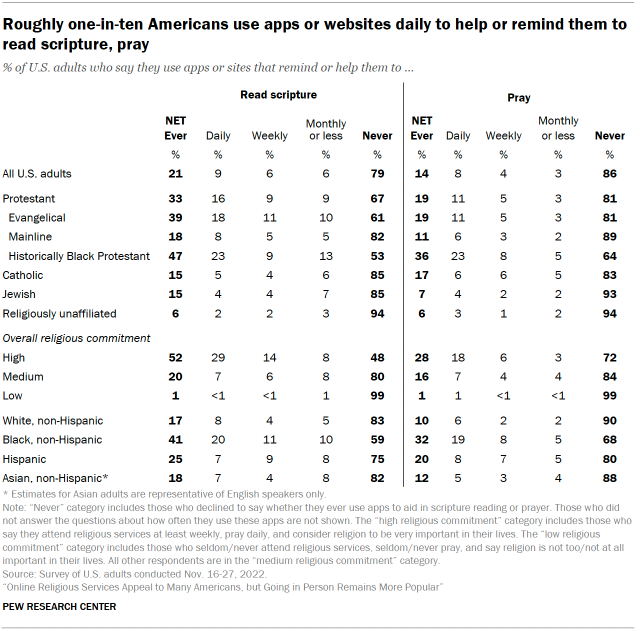
And, by just a slight margin, younger adults outpace older adults in using apps or sites that encourage meditation. Roughly a quarter of adults under 50 (22%) say they use apps or sites to help (or remind) them to meditate, compared with 16% of those ages 50 to 64 and 9% of those 65 and older.
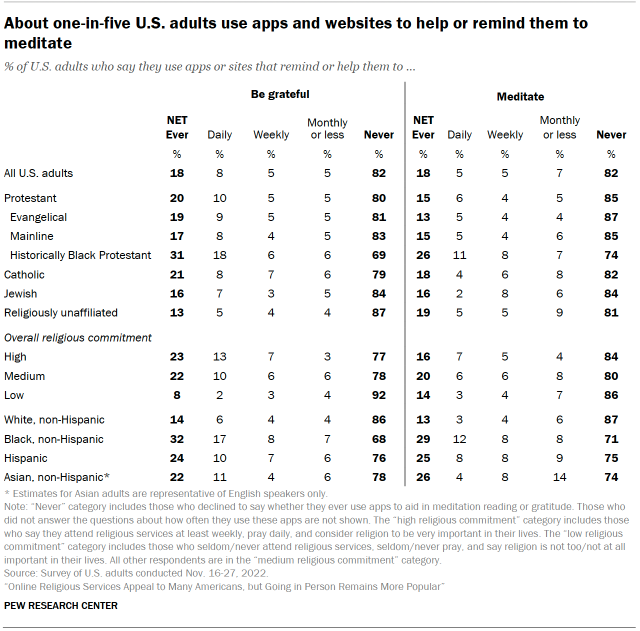
Following religious leaders digitally
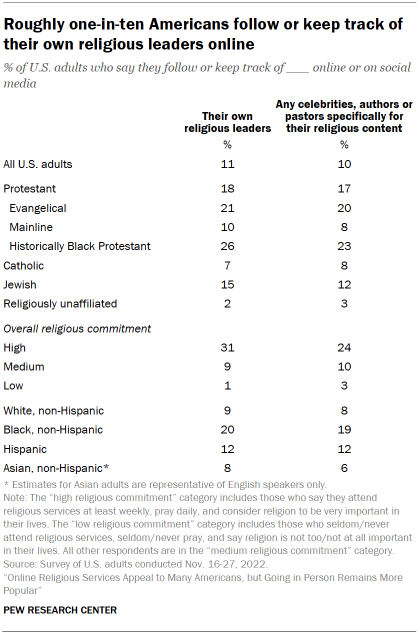
Overall, 11% of U.S. adults say they follow or keep track of their own religious leaders online or on social media. Similarly, one-in-ten say they follow or keep track of anycelebrities, authors or pastors specifically for their religious content online.
About a quarter of Americans who affiliate with historically Black Protestant churches say they use the internet or social media to follow or keep track of their own religious leaders (26%) or any celebrities, authors or pastors specifically for their religious content (23%). Evangelical Protestants are the next most likely religious group of those analyzed to say they do these things; about one-fifth of evangelicals follow their own clergy or other creators of religious content online.
Using digital tools to seek information about religion
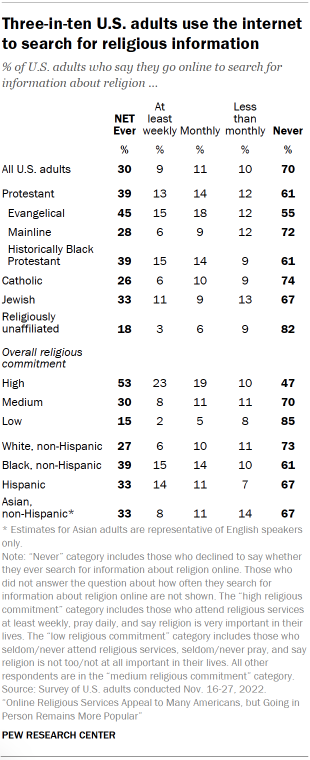
The survey assessed Americans’ general online religious curiosity and activity by asking whether – and how often – they take to the internet to search for information about religion. Three-in-ten U.S. adults say they do this, including 9% who say they search online for religious information weekly or more often, 11% who do it monthly, and 10% who do it on occasion but less than monthly. Still, a large majority of U.S. adults (70%) say they never go online to search for information about religion.
Among U.S. adults who affiliate with either evangelical Protestant denominations or historically Black Protestant churches, 15% say they use the internet to search for religious information at least weekly, compared with just 3% of the religiously unaffiliated (those who identify as atheist, agnostic or nothing in particular).
Across religious lines, roughly half of adults with a high level of religious commitment (53%) say they search online for information about religion. This includes 23% who say they do so at least once a week.
Watching online videos and podcasts for religious content
Two-in-ten U.S. adults say they consume religious content through online videos, for example, on YouTube or TikTok, and 15% say they listen to religion-focused podcasts. (The question about online videos asked whether respondents watch online videos other than religious services. Other questions in the survey asked specifically about watching religious services online.)
While younger adults use YouTube and TikTok more often than older adults in general (meaning, for all online content, about all topics), there is essentially no variation by age among those who say they watch videos specifically about religion. A similar pattern emerges when comparing general podcast consumption with podcasts that focus on religion. This could be because younger Americans tend to be less religious than older ones.
Overall, adults in the historically Black Protestant tradition and evangelicals are more likely than other religious groups to say they ever watch religion-focused videos online (44% and 38%, respectively). And nearly one-in-ten (9%) Black adults overall (irrespective of religious tradition) say they watch religion-focused online videos every day (9%), compared with 4% of the general adult population.
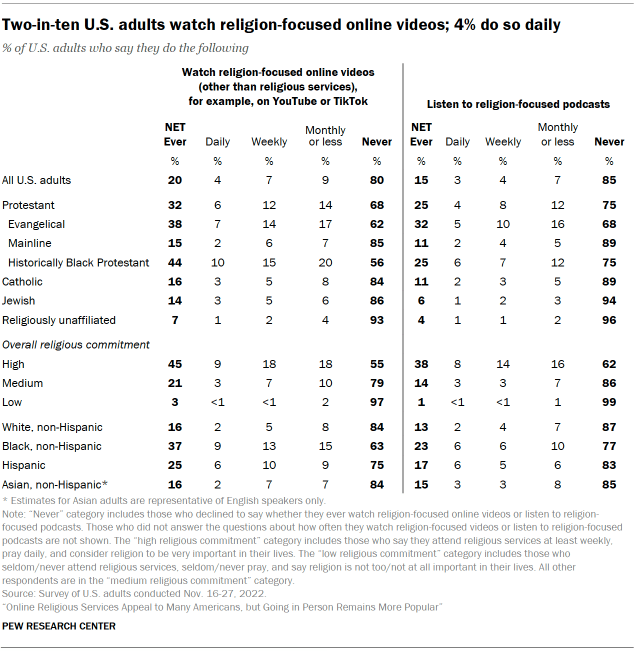
Engaging with religion through books and radio
In addition to asking about the use of digital technology to get religious content, the survey also asked about more traditional ways of accessing information about religion.
About a third of U.S. adults (34%) say they read religion-focused books, which is more than the 20% who say they watch religion-focused videos online. And a quarter of U.S. adults report listening to religious radio stations – more than the 15% who listen to religion-focused podcasts.
Among Protestants, majorities of evangelicals and those in the historically Black tradition read books which focus on religion or listen to religious radio stations, including about three-in-ten adults in both groups who say they do this at least weekly. Meanwhile, about a quarter of U.S. Jews (24%) read religion-focused books at least weekly, and 14% listen to religious radio stations weekly. By contrast, only about one-in-ten or fewer religiously unaffiliated Americans say they ever do these things.
Looking at age differences, U.S. adults ages 65 and older are much more likely than Americans ages 18 to 29 to say they ever read books focused on religion (42% vs. 23%) as well as to report that they do so at least weekly (23% vs. 11%).
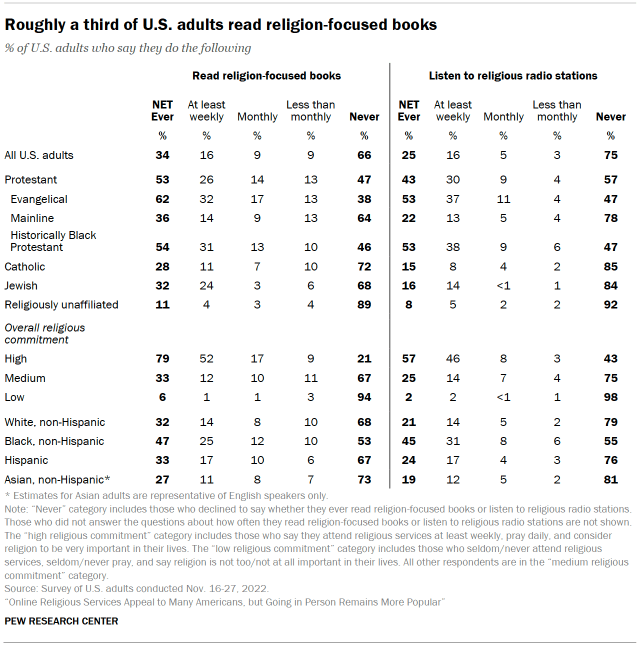
Online and in-person participation in religious learning programs
Overall, fewer than one-in-ten Americans (7%) say they ever participate in online prayer groups, scripture study groups or religious education programs, compared with more than twice as many (19%) who say they say participate in such groups in person. Just 4% engage in these activities online at least weekly, compared with 11% who do so in person that frequently.
Evangelical Protestants (23%) and those in the historically Black Protestant tradition (20%) stand out when it comes to meeting in person for at least one of these activities at least weekly. Meanwhile, 14% of Jews say they do this.
Overall, 4% of U.S. adults say they participate at least once a month in both online and in-person versions of prayer groups, scripture study groups or religious education programs.
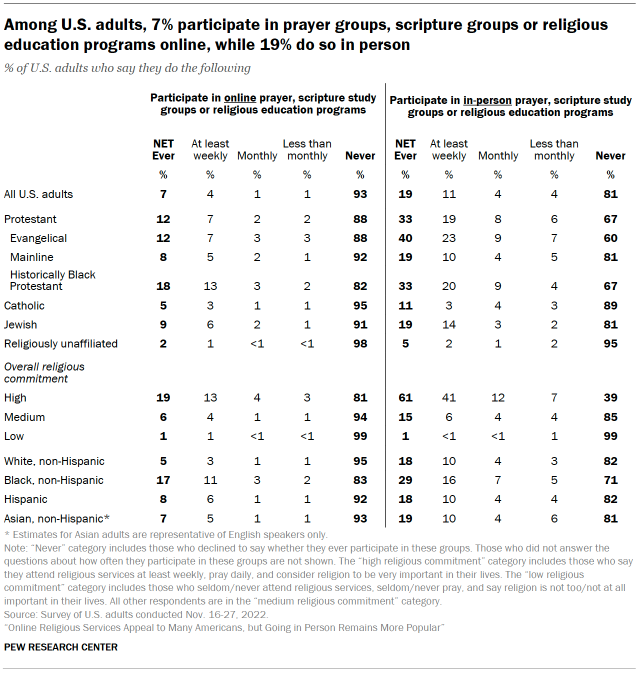
Sharing content about religion and prayer requests on social media

The survey finds that 17% of all Americans post or share things about religion on social media, including 2% who do this daily, 3% who do it weekly, and 12% who do it monthly or less often. The vast majority of Americans (83%) do not post or share things about religion on social media.
Evangelical Protestants and those in the historically Black Protestant tradition are more likely to post about religion on social media (31% of each say they ever do this), including 6% of members of historically Black Protestant churches who report doing so daily.
Meanwhile, about one-in-ten U.S. adults (11%) say they post prayer requests online, such as on social media sites, including 2% who say they do this daily. Not surprisingly, far more (42%) say they see other people’s prayer requests online, including 9% who say they see these types of posts daily.
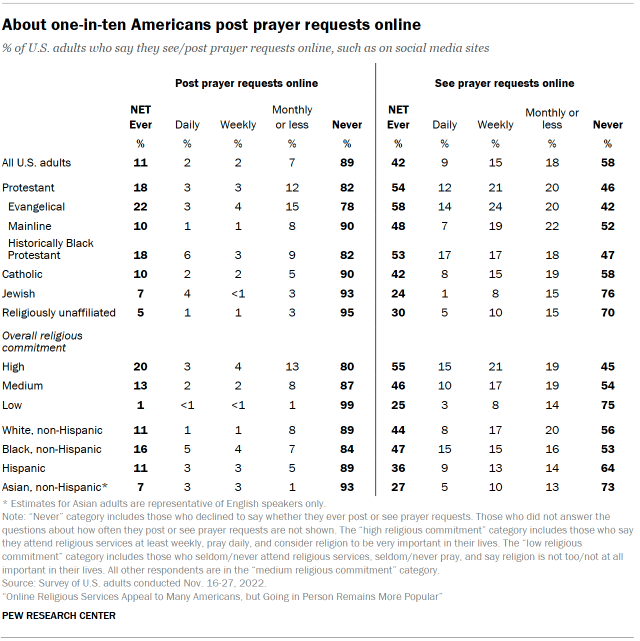
Blocking or unfollowing people due to religion content posted online
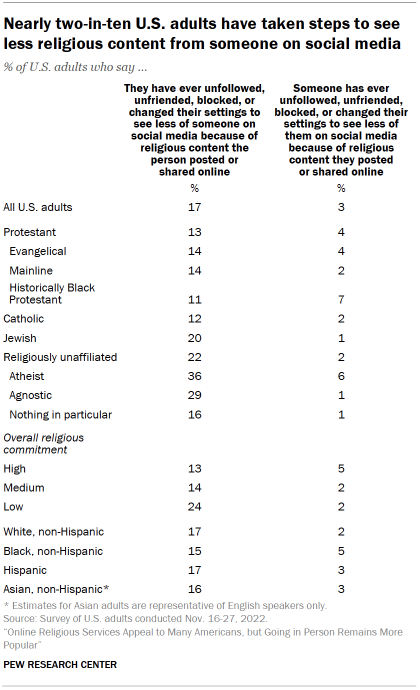
Some 17% of U.S. adults say they have unfollowed, unfriended, blocked, or changed their settings to see less of someone on social media because of religious content the person posted or shared online.
Younger adults are slightly more likely to say they have ever done this on social media. About a quarter of Americans ages 18 to 29 say they have done so (23%), compared with 7% of those 65 and older.
Atheists and agnostics are more likely than people in most other religious affiliation categories to say they have blocked, unfollowed, unfriended, or changed their settings to see less of someone online due to religious content on social media. Just over a third of atheists (36%) and 29% of agnostics say they have done this.
The survey also asked respondents whether, as far as they know, they have ever been unfollowed, unfriended or blocked by someone who wanted to see less of them on social media because of religious content they posted or shared. Only 3% of U.S. adults say this has happened to them.
Scale of religious technology use online
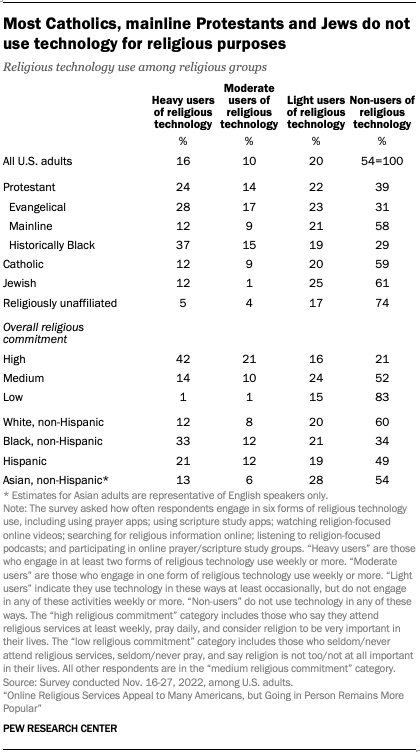
Researchers combined six of the questions explored in this chapter into a single, overall indicator (or scale) of religion-related technology use online. The six items are: using apps or websites to help with prayer; using apps or websites to help with reading scripture; watching religion-focused online videos; searching for religious information online; listening to religion-focused podcasts; and participating in online prayer groups, scripture study groups or religious education groups. The scale can be used to categorize Americans as “heavy users,” “moderate users,” “light users” and “non-users” of religious technology online.
Overall, 16% of U.S. adults are heavy users of religious technology, meaning they engage in two or more kinds of online technology for religious purposes at least once a week. An additional 10% are moderate users, engaging in one kind of religious technology use at least weekly. One-fifth of U.S. adults are light users who engage in religious technology at least occasionally, but not weekly or more often. The remaining 54% are categorized as non-users of religious technology since they do not use online technology in any of these ways.
Notable differences by religious affiliation emerge from this analysis. Members of the historically Black Protestant tradition are more likely than people in other religious groups to be heavy users of technology for religious reasons (37%). At the other end of the scale, non-users include majorities of mainline Protestants (58%), Catholics (59%) and Jews (61%). Roughly three-quarters (74%) of religiously unaffiliated adults (those who describe themselves as atheist, agnostic or nothing in particular) are also non-users of religious technology.




